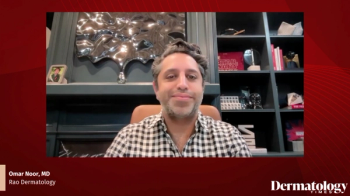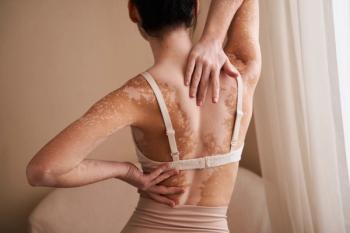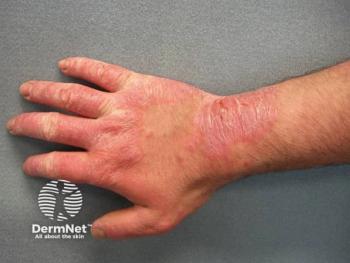
- Dermatology Times, August 2025 (Vol. 46. No. 08)
- Volume 46
- Issue 08
From Scalp to Skin: Modernizing Psoriasis Treatment With Versatile Topical Solutions
Key Takeaways
- Traditional topical corticosteroids are effective but limited by adverse effects, necessitating safer long-term alternatives for psoriasis management.
- Novel nonsteroidal agents, tapinarof and roflumilast, offer steroid-sparing efficacy, broad applicability, and improved adherence with once-daily dosing.
Explore the latest advancements in psoriasis treatment with innovative topical therapies, enhancing patient outcomes and simplifying management for diverse skin types.
What is the evolving role of topical therapies for patients with psoriasis? Mona Shahriari, MD, FAAD, associate clinical professor of dermatology at Yale University School of Medicine in New Haven, Connecticut, cofounder of Central Connecticut Dermatology, and a Dermatology Times Editorial Advisory Board member; and James Song, MD, co–chief medical officer and clinical research director at Frontier Dermatology, explored these nuancesin a recent Dermatology Times DermView custom video series titled Psoriasis From Head to Toe: Tackling Scalp and Body Psoriasis With Topical Treatment.
Unmet Needs and Evolving Topicals
For years, traditional topical treatments have left something to be desired for providers and their patients with psoriasis on all areas of the body. Topical corticosteroids, while effective for acute flares, come with restrictions on long-term use due to potential adverse effects such as skin atrophy, stretch marks, and telangiectasias. These limit their application, especially in sensitive areas.
“I’ve always thought of steroids, whether we’re dealing with topical or oral, [as having] to be a bridge to somewhere,” Shahriari noted. “They cannot be the chronic treatment for chronic disease, because they are never meant to be chronic therapies.”
Nonsteroidal topicals, though safer for prolonged use, have often lagged in efficacy and tolerability, with some causing irritation or having less-than-ideal cosmetic vehicles. These multitudes of creams can be confusing for patients, marking an urgent need for simplified solutions.
Challenges in Specific Body Areas
Scalp psoriasis is a particularly challenging area to treat effectively with topicals. Despite its often-limited body surface area, scalp involvement disproportionately impacts patients’ quality of life. Traditional vehicles such as greasy ointments or alcohol-based solutions are often poorly tolerated due to cosmetic concerns or irritation, especially in patients with tightly coiled or textured hair.
Another critical challenge lies in the diagnosis and treatment of psoriasis in skin of color. The classic salmon-pink plaques with silvery scales, typically seen in lighter skin tones, can appear as purplish gray or reddish brown in skin of color, often leading to diagnostic delays.“I’ll be the first to admit that in my training, we didn’t see that much skin of color,” Song shared. “We were in Southern California with a lot of Caucasian and Asian skin. So, for me, it took time. It took attending seminars and talking with other experts to really kind of train and recalibrate my eyes to appreciate the different tones of erythema that we can see.”
The Promise of Novel Topical Therapies
Shahriari and Song highlighted 2 innovations, tapinarof cream (Vtama; Organon) and roflumilast cream (Zoryve; Arcutis Biotherapeutics), as novel nonsteroidal agents. These medications offer a significant leap forward by providing the following:
Steroid-sparing efficacy: Both agents demonstrate efficacy comparable with potent topical corticosteroids, allowing for long-term use without the associated adverse effects.
Broad applicability: Their formulations and favorable tolerability profiles allow for simplified use across various areas, including sensitive regions and hair-bearing skin.
Once-daily dosing: This convenience significantly improves patient adherence.
Novel mechanisms of action: Tapinarof, an aryl hydrocarbon receptor modulating agonist, and roflumilast, a next-generation PDE4 inhibitor, offer distinct pathways for targeting psoriasis pathogenesis.
Sustained disease control: Clinical data suggest that tapinarof may offer remittive effects, while roflumilast has shown maintained clearance with intermittent use.
Prioritizing Safety and Tolerability
A significant advantage of these next-generation topical treatments lies in their superior safety and tolerability profiles compared with topical corticosteroids. In long-term extension studies, investigators do not see adverse effects such as tachyphylaxis, hypothalamic-pituitary-adrenal axis suppression, and striae. This addresses key concerns that have historically limited the long-term use of corticosteroids. Adverse events associated with topical tapinarof and roflumilast are generally mild and manageable.
Foam Formulations for Scalp Psoriasis
A significant breakthrough discussed is roflumilast foam for scalp psoriasis, which was approved by the US Food and Drug Administration in May 2025. This formulation directly addresses the unmet need for an effective, user-friendly, and cosmetically elegant option for hair-bearing areas.
Song expresses his pleasant surprise at its efficacy, noting that it achieved clear or almost clear status in more than 60% of patients with moderate to severe scalp psoriasis. Shahriari enthusiastically shared her personal experience using it for seborrheic dermatitis.
“I could never use a topical consistently on my scalp. I would have issues in terms of my hair styling and just the greasiness factor,” she said. “But this is very hydrating. To be able to use it so easily has really improved my adherence to the regimen, and I’ve actually been able to see the results. It just makes my life so much simpler.”
The foam formulation of roflumilast also stands out for its zero-alcohol content, making it less drying and irritating, especially for patients with sensitive scalps or those with skin of color and specific hair care practices. Song adds that roflumilast’s absence of propylene glycol makes it a safe option for patients with known allergies to this common irritant found in many topical products.
Improving Patient Outcomes
The availability of both cream and foam formulations of roflumilast, alongside tapinarof cream, offers clinicians and patients unprecedented flexibility. Patients can now “pick their own adventure,” choosing the vehicle that best suits their needs and preferences, promoting better adherence. This simplification of regimens can lead to fewer prescriptions and a clearer understanding of where and how patients apply their medication, reducing treatment burden.
Articles in this issue
3 months ago
Examining Bond-Building Hair Care Treatments4 months ago
Dermatology Times August 2025 Print RecapNewsletter
Like what you’re reading? Subscribe to Dermatology Times for weekly updates on therapies, innovations, and real-world practice tips.



















